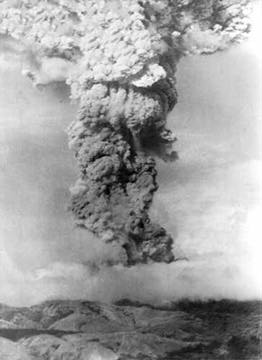Rincon Home Page --> Rincon Eruption (this page)
Volcanic Hazards at Rincon de la Vieja
Phreatic eruption at Rincon de la Vieja, January, 1967
(photographer unidentified)
Rincon de la Vieja most recently erupted in November, 1995, and is being monitored closely by geoscientists in Costa Rica. A recent report on this eruptive episode indicates that the eruption was similar to previous phreatic eruptions, producing lahar avalanches to the north but contained no juvenile magma.
Volcanic hazard evaluations are often based on detailed geologic and geochronologic studies of a volcano's past activity, using the assumption that future eruptions will be of similar eruptive style and volume (Blong, 1984). The modern topography of the volcano is also an important consideration, as exemplified by the accurate prediction of lahar distributions during the 1985 Nevado del Ruiz eruption, which killed approximately 23,000 people (Anonymous, l985; Williams, l987).
As the last major eruption at the volcano involving juvenile magma, the interpretation of the Rio Blanco tephra deposit is crucial for predicting the style of future eruptions. Since the Rio Blanco tephra eruption, explosive phreatic and phreatomagmatic eruptions from the Active Crater have only deposited minor amounts of tephra and ash in the vicinity of the Active Crater.
A volcanic hazards map and discussion is presented in this study, assessing deposits formed by (1) debris avalanches (2) sub-plinian to plinian tephras, (3) pyroclastic flows and lahars, and (4) lava flows. In general, areas immediately north of the Active Crater are in the highest hazard zone, primarily from lahars or debris/pyroclastic flows associated with explosive eruptions. Plinian-style eruptions would most likely affect large areas W and SW of the volcano, however, in a zone roughly coincident with the Rio Blanco tephra distribution.
Back to Home Page
Pre-Rincon Geology |
Volcanic Hazards |
Rincon Geology

